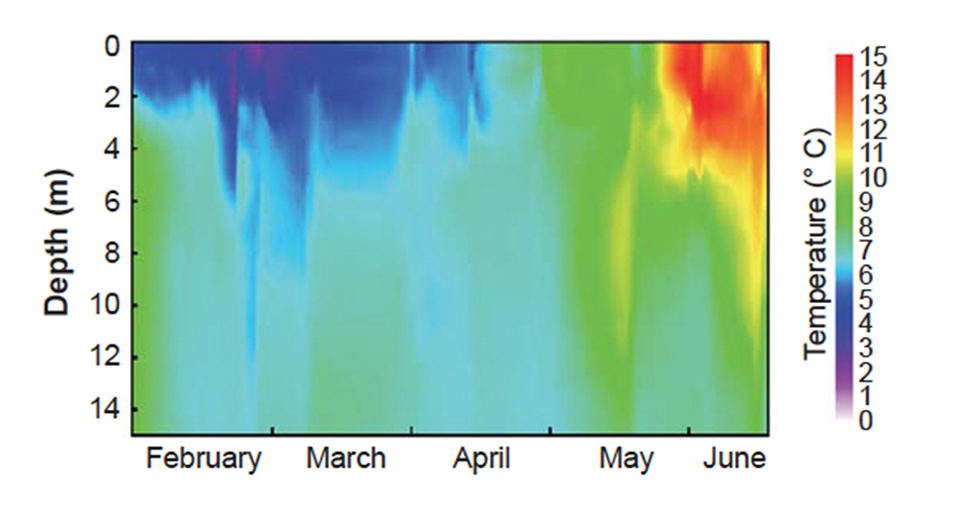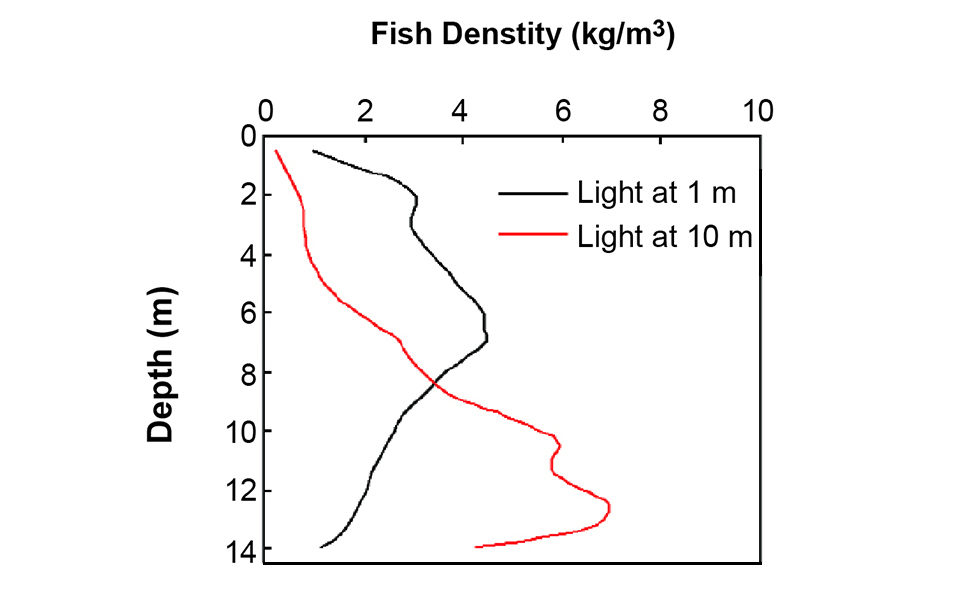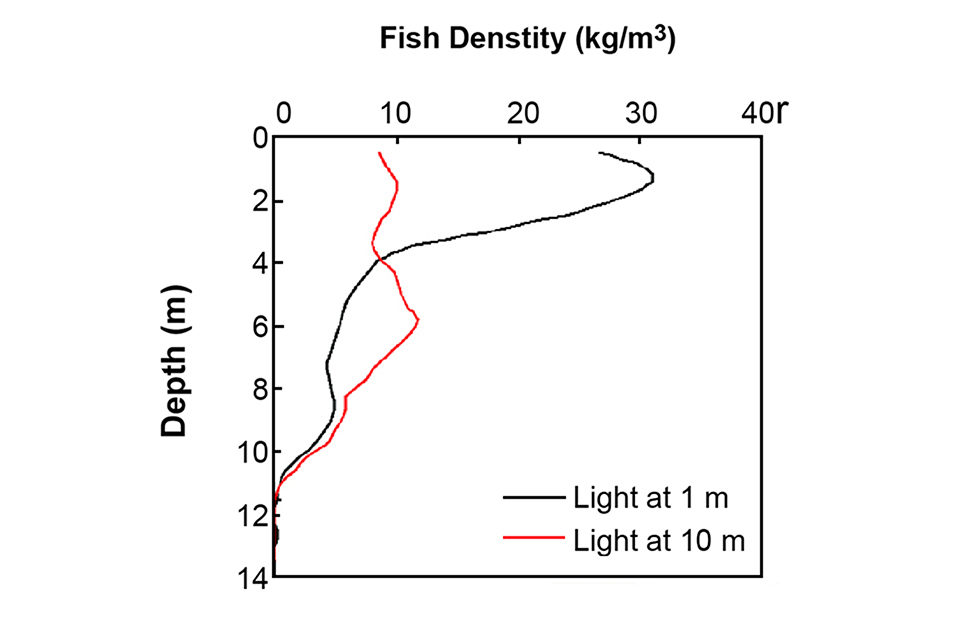Underwater lights should be positioned at water depths with optimal available temperatures
Since the early 1990s, salmon farmers have added lights to their cages from midwinter to midsummer to reduce the incidence of sexual maturation and improve fish growth. Preventing sexual maturation reduces the number of fish “classed down” at harvest. In addition, salmon lose some of their adaptation to the saline environment as they mature sexually.
Light positioning
Initially, light sources were mounted above water, but as quality underwater light sources were produced, they replaced the former because they produced less reflections and disturbance to passing ships, and were more energy efficient because more light reached the fish. However, the best depth placement of light sources has been under debate.
Early studies revealed that lights attract salmon. By changing the lights’ depth, the salmon follow, and a relatively high fish density is found near the depth of the light sources. Through the use of several light sources positioned at different depths, a more disperse distribution of swimming depths and lower schooling densities were observed. However, in other studies performed in a temperature-stratified environment, the salmon preferred the warmest water available, as long as it did not exceed approximately 17 degrees-C.
Depth experiment
In order to investigate the salmon’s preferences for light and temperature, the authors carried out a large-scale experiment at the Institute of Marine Research Cage Environment Lab at Solheim in Masfjorden, Norway. Atlantic salmon (Salmo salar) with an average weight of 0.3 kg were stocked into three 12-meter x 12-meter x 14-meter-deep sea cages at 2.2 kg per cubic meter. The fish grew to an average weight of 1.4 kg in January and a density of 9.9 kg per cubic meter.
Each cage was illuminated by two 400-watt underwater metal halide lights positioned at depths of 1.0, 5.0 and 10.0 cm in winter, spring, and summer. Swimming depth and observed fish density were registered by echo sounders at 0.5-meter depth intervals. Temperature, salinity, light, and dissolved oxygen data were continuously monitored from the surface to a 15.0-meter depth at a reference point outside the sea cages.
Temperature, light effects
Water temperatures showed typical seasonal variations for a fjord site, with the coldest water close to the surface during winter and warmest water at the surface in the summer (Fig. 1).

During daytime, the salmon predominantly preferred swimming in the warmest water, which was at deeper depths in the cages during winter, at variable and mid-cage depths during spring, and close to the surface in the summer. At night, the fish preferred the warmest water and were attracted to the light sources.
Generally, salmon swam deep in the cages when light sources were positioned at 10 m in the winter, while some fish swam closer to the surface when lights were positioned at 1-meter depth (Fig. 2). The reverse situation was observed in the summer, with all fish swimming close to the surface when lights were 1 meter deep. The salmon swimming depth was more evenly distributed between the surface and the light sources when the lights were positioned 10 m deep (Fig. 3). With the light sources positioned at a 5-meter depth, most fish swam at this depth during winter, while the preference was partly overruled by the warm water in the shallower depths in summer.


In spring, the temperature profile was variable, and at times stratification was not present. Nevertheless, the overall trend observed included attraction by both temperature and lights. When the temperature range was about 8 degrees-C, the temperature attraction seemed most important, while at a narrower 3 degrees available temperature range, both light and temperature were preferred. The preference – or avoidance of darkness and low temperatures – was at times so strong that fish grouped at 10 times the stocking density.
Behavior control
For salmon and other cold-blooded animals, temperature is an important physiological parameter. These animals normally display best appetite and growth around their temperature optimums.
Light is important for the schooling behavior of fish. In a cage with thousands of individuals, maintenance of schooling can reduce stress. Fish eyes have a relatively slow adaptation to dark conditions, and the schooling behavior in salmon cages is reduced under dark conditions. The authors believe that salmon approach light sources at night in order to carry on their schooling behavior.
Overall, the observations of salmon behavior in the study indicated a compromise between individuals’ needs for sufficient light intensity and a preference for optimal temperature.
Recommended positioning
At commercial salmon farms, underwater lights should be positioned at water depths with optimal available temperatures to support the best growth of fish. Normally this would imply a relatively deep positioning in winter and shallower depths toward summer.
It is important that salmon farmers measure temperature profiles with depth on a daily basis to register seasonal variations and adjust light position accordingly. Another option is to position several light sources at different depths. Under such conditions, the fish will spread evenly in the water volume when stratification is absent. But this could be inefficient under stratified conditions, as the fish would prefer the water volume with the most favorable temperature.
(Editor’s Note: This article was originally published in the March/April 2007 print edition of the Global Aquaculture Advocate.)
Now that you've finished reading the article ...
… we hope you’ll consider supporting our mission to document the evolution of the global aquaculture industry and share our vast network of contributors’ expansive knowledge every week.
By becoming a Global Seafood Alliance member, you’re ensuring that all of the pre-competitive work we do through member benefits, resources and events can continue. Individual membership costs just $50 a year. GSA individual and corporate members receive complimentary access to a series of GOAL virtual events beginning in April. Join now.
Not a GSA member? Join us.
Authors
-
-
David Johansson
Institute of Marine Research
5984 Matredal, Norway -
Jon-Erik Juell
Institute of Marine Research
5984 Matredal, Norway
Tagged With
Related Posts

Intelligence
A brief look at genetically modified salmon
If approved by FDA, fast-growing genetically modified salmon will provide a safe and nutritious product similar to other farmed Atlantic salmon.

Intelligence
A land grab for salmon (and shrimp) in upstate New York
The operators of Hudson Valley Fish Farm see their inland locale as a pilot to prove that land-based fish farming, located in close proximity to major metropolitan markets, can be successful.

Responsibility
A look at integrated multi-trophic aquaculture
In integrated multi-trophic aquaculture, farmers combine the cultivation of fed species such as finfish or shrimp with extractive seaweeds, aquatic plants and shellfish and other invertebrates that recapture organic and inorganic particulate nutrients for their growth.

Aquafeeds
A new nutrient for aquaculture, from microbes that consume carbon waste
Biotechnology firm NovoNutrients aims to produce a line of nutraceutical aquafeed additives as well as a bulk feed ingredient that can supplement fishmeal. Its process includes feeding carbon dioxide from industrial gas to a “microbial consortium” starring hydrogen-oxidizing bacteria.


